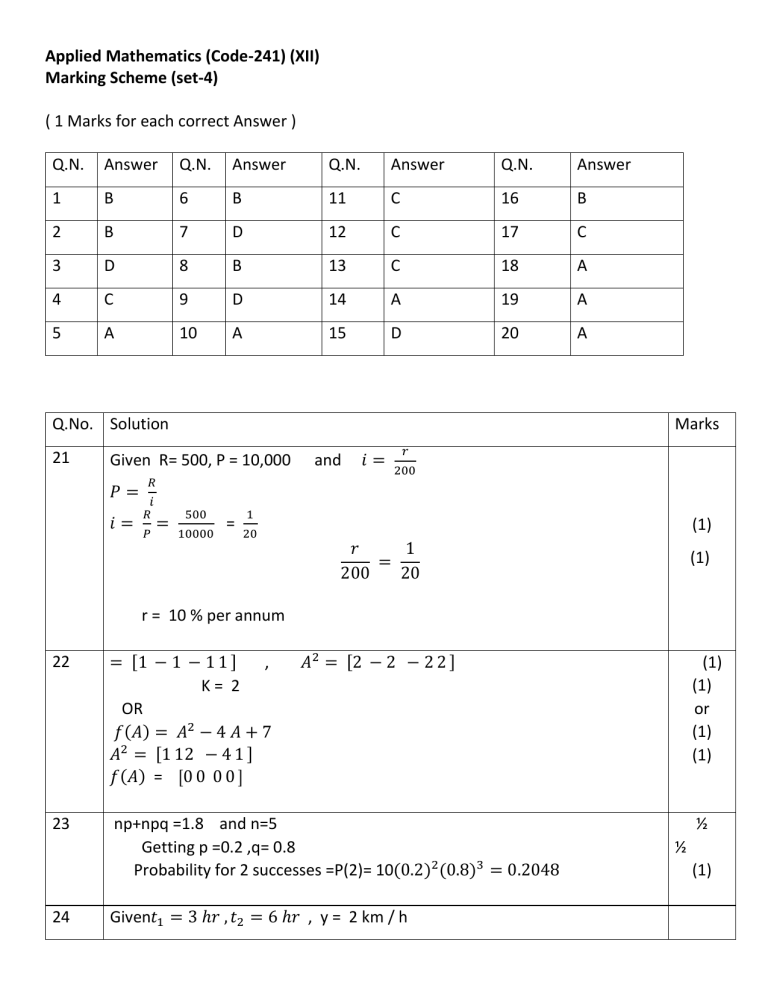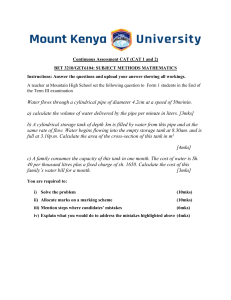
Applied Mathematics (Code-241) (XII) Marking Scheme (set-4) ( 1 Marks for each correct Answer ) Q.N. Answer Q.N. Answer Q.N. Answer Q.N. Answer 1 B 6 B 11 C 16 B 2 B 7 D 12 C 17 C 3 D 8 B 13 C 18 A 4 C 9 D 14 A 19 A 5 A 10 A 15 D 20 A Q.No. Solution 21 Marks Given R= 500, P = 10,000 𝑃= 𝑖= 𝑅 𝑖 𝑅 𝑃 = 500 10000 = and 𝑖= 𝑟 200 1 20 (1) 𝑟 1 = 200 20 (1) r = 10 % per annum 𝐴2 = [2 − 2 − 2 2 ] 22 = [1 − 1 − 1 1 ] , K= 2 OR 𝑓(𝐴) = 𝐴2 − 4 𝐴 + 7 𝐴2 = [1 12 − 4 1 ] 𝑓(𝐴) = [0 0 0 0 ] 23 np+npq =1.8 and n=5 Getting p =0.2 ,q= 0.8 Probability for 2 successes =P(2)= 10(0.2)2 (0.8)3 = 0.2048 24 Given𝑡1 = 3 ℎ𝑟 , 𝑡2 = 6 ℎ𝑟 , y = 2 km / h (1) (1) or (1) (1) ½ ½ (1) 𝑥= 𝑦 (𝑡1 + 𝑡2 ) (1) (𝑡2 − 𝑡1 ) X = 6 km / h (1) Hence speed of man in still water = 6 km / h OR Ramesh runs 5 m in 3 seconds Time taken to run 200 m = 3 5 (1) (1) × 200 (1) = 120 second 𝑣𝑓 = 216000, 𝑣𝑖 = 200000 25 Nominal Rate = 𝑣𝑓 − 𝑣𝑖 𝑣𝑖 = (1) × 100 16000 200000 (1) × 100 = 8% 26 2006 - 63 2007-60.5 2008 – 56.25 2009- 53.5 2010- 53.5 2011- 52.5 Year (t) 2015 2016 2017 2018 2019 (½ marks for each part ) OR X= 𝑡𝑖 − 2017 -2 -1 0 1 2 Y 9 18 21 29 38 115 𝑎= And 𝑏= ∑ 𝑥𝑦 ∑ 𝑥2 ∑ 𝑦 𝑛 = = 69 /10 = 6.9 𝑦𝑡 = 𝑎 + 𝑏 𝑥 , 𝑦𝑡 = 23 + 6.9 𝑥 Draw the graph 𝑥𝑖 2 4 1 0 1 4 10 115 = 23 5 xy -18 -18 0 29 76 69 27 40(1 − Quantity of milk after n operation = 4 3 ) 40 (2) (1) = 29.16 28 𝑥2 (𝑥−1)(𝑥−2)(𝑥−3) ∫ = ( ∫ = 1 2 1 2 𝑥− 1 + (2) 𝑑𝑥 −4 𝑥−2 9 2 + 𝑙𝑜𝑔 𝑥 − 4 𝑙𝑜𝑔 𝑙𝑜𝑔 𝑥 + 𝑥− 3 9 2 ) 𝑑𝑥 (1) 𝑙𝑜𝑔 𝑥 + C OR OR (1) −1 0 (1) 1 − ( x − x)dx + ( x − x)dx − ( x − x)dx 3 3 −2 −1 3 0 (1) for integration =11/4 29 t= x− s (1) n = 2.24 (1) Degree of freedom =20-10=19 (1) and t 0.05 = 1.729 null hypothesis is rejected since t – statistics more than the tabulated value 30 (1) Cost of house = 4500000 Down payment = 500000 Balance amount = 40,00000 So, P = 40,00000 , 𝑖 = 6 12 𝑥100 (1) = 0.005𝑛 = 25 𝑥 12 = 300 EMI = = 𝑝 𝑥 𝑖 𝑥(1+ 𝑖)𝑛 (1+𝑖)𝑛 −1 4000000 𝑥 0.005 (1.005)300 (1.005)300 −1 (1) = 25772, Hence EMI = 25772. = 𝑅 ( (1+𝑖 )𝑛 −1 ) 31 𝑅= 𝑖 here 𝑖 = 5 200 = 0.025 𝐴𝑋𝑖 (1 + 𝑖 )𝑛 − 1 (1) (2) R = 39148 32 Probability of defective buckets = 0.05 n = 100 𝑚 = 𝑛𝑝 = 5 (1) Let X = number of defective buckets in a sample of 100 𝑝(𝑋 = 𝑟 ) = 𝑒 −𝑚 𝑚𝑟 𝑟! , r= 0,1,2,3,------ (i) P(No of defective buckets) = p(r=0) 𝑒 −550 = 0! = 𝑒 −5 = 0.0067 (2) (ii) P(At most one defective buckets) = P(r=0,1) (2) = 𝑒 −5 50 0! + 𝑒 −5 51 1! = 0.0402 OR = 0.0067 + 0.0335 (1) X=scores of students,𝜇=45,𝜎=5, 𝑍= (i) 𝑋− 𝜇 𝜎 (2) = ( X- 45 )/ 5 (2) When X =45,𝑍=0 P (X>45)=P(Z>0) =0.5 ⇒50% students scored more than the mean score ( (ii) When X =30,𝑍=−3 and when X =50, 𝑍=1 P (30<X<50)=P(-3<Z<1)=P(-3< Z≤1) = P(−3<𝑍≤0)+ 𝑃(0≤Z<1) = P(0≤𝑍<3) + 𝑃(0≤Z<1) = 0.4987 +0.3413= 0.84 ⇒84% students scored more than the mean score 33 Let 𝑥be the number of guests for the booking Clearly,𝑥>100to avail discount Profit P = ⌊4800 − 200(𝑥−100) ⌋𝑥 10 = 6800𝑥 − 20 𝑥 2 (1) 𝑑𝑝 = 6800 − 40 𝑥 𝑑𝑥 𝑑𝑝 𝑑𝑥 = 0 , get x= 170 𝑑2𝑝 𝑑2𝑥 (1) = −40 < 0 (1) (1) A booking for 170 guests will maximise the profit of the company And, Profit= P = ⌊4800 − 200(𝑥−100) ⌋𝑥 10 , put x= 170 we get (1) (1) Profit = ₹5,78,000 OR (1) P(x)= R(x)–C(x) = 5x–(100+ 0.025x2) ⇒P’(x)=5 –0.05x (1) P’(x)= 0 ⇒𝑥=100 AsP’’(x)=−0.05<0,∀𝑥 ∴ Manufacturing 100 dolls will maximise the profit of the company And, 2 (1) (1) P(x)= 5x–(100+ 0.025x ) Put x= 100 we get total Profit=₹1,50,000 34 cost of new machine =65000 Net amount required at the end of 25 year = 62500 is R= (1+ i ) n 0.035X 62500 = 1604.68 25 −1 , R = (1.035) − 1 (1) (1) (2) (1) Thus rs . 1604.68 are set aside each year out of the profits. 35 Here D = −1 , (1) D1 = -11 (1) D2= -92 (1) D3= -53 (1) By Cramer’s rule 𝑥= 36 𝐷1 −11 = 𝐷 −1 (1) 𝐷2 = 11, 𝑦 = 𝐷 = −92 −1 𝐷3 = 92 𝑧 = = 𝐷 −53 −1 = 53 (1) Pipe C empties 1 tank in 12 hr. = 2 𝑡ℎ𝑒 tank in 5 2 5 𝑥12 = 24 5 ℎ𝑟 = 4 4 5 ℎ𝑟 1 1 6 8 (2) Part of tank filled in 1 hour = + 1 − 12 = time taken to fill tank completely = 24 = (1) 5 24 ℎ𝑟. = 4 5 4 5 ℎ𝑟. (3) At 5 am, Let the tank be completely filled in ‘t’ hours (1) ⇒pipe A is opened for ‘t’ hours pipe B is opened for ‘t−3’ hours And, pipe C is opened for ‘t−4’ hours ⇒In one hour, part of tank filled by pipe A = part of tank filled by pipe B = And 𝑡 (2) 6 𝑡−3 8 part of tank filled by pipe C = 𝑡−4 12 Hence 𝑡 6 + 𝑡−3 8 - 𝑡−4 12 𝑡=5 =1 , Total time to fill the tank -= 5 hrs. OR 6 am, pipe C is opened to empty ½ filled tank Time to empty = 24 5 hours Time for cleaning = 1 hour Part of tank filled by pipes A and B in 1 Hour = 1 6 + 1 8 = 7 24 Part of tank filled by pipes A and B in 1 hour=1/15+1/12 +1/20 =3/20 th tank ⇒time taken to fill the tank completely = Total time taken in the process 24 7 hours = 37 24 5 +1+ 24 7 = 323 35 ℎ𝑟𝑠 =9 8 35 ℎ𝑟𝑠 equation of AD 2x + y = 50 (1) Equation of BC x+2y= 40 (1) (1) the co-ordinates of points B and C B (20,10) and C (0,20) (2) OR the Constraints for the LPP. (1) 2x+y <=50, (1) X+2y<=40, (2) x>=0,y>=0.


